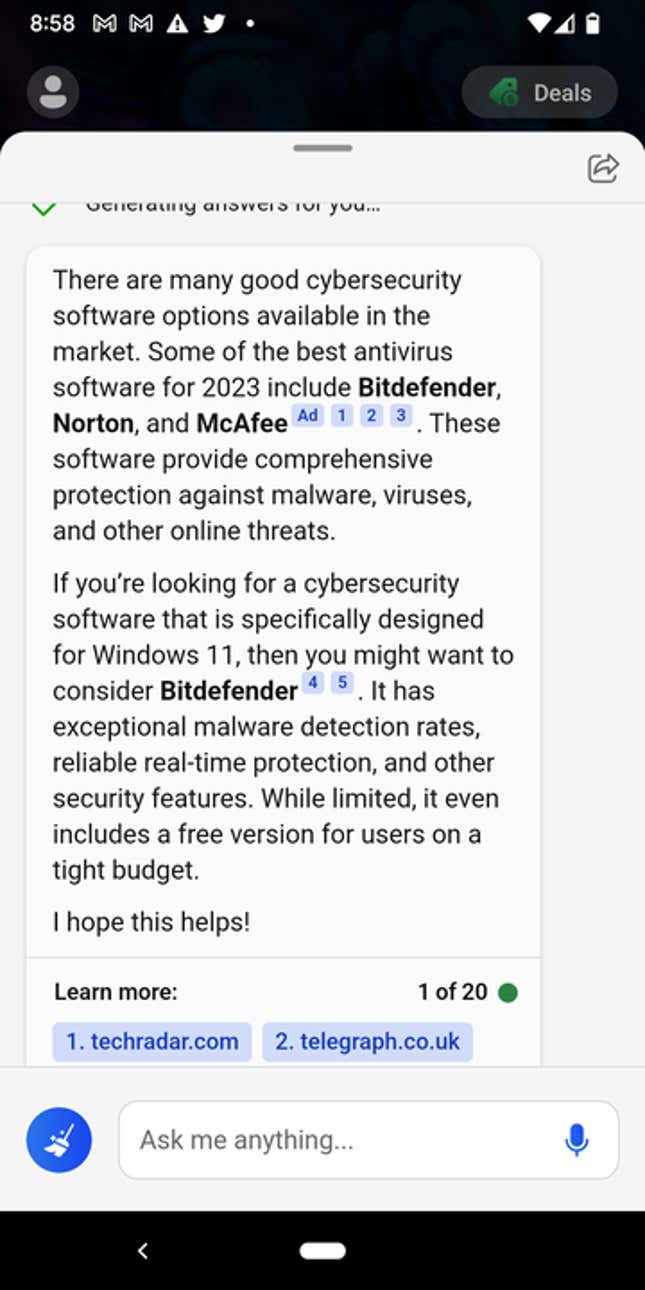With the AI-arms race in full swing, it’s no surprise that tech giants like Microsoft are shifting their attention to monetization. As with so many struggles, the real question of who comes out winning will probably be determined by who manages to make the most profit. Enter: Bing Chat ads.
Microsoft acknowledged its efforts to bring advertising to its “new Bing” chat experience in a Wednesday blogpost. In a brief bullet point at the end of the post, which was mostly about user traffic, company exec Yusuf Mehdi summarized the current state of Bing’s chat ad strategy.
Advertisement
He wrote that the company is “placing a rich caption of Microsoft Start licensed content beside the chat answer helping to drive more user engagement with the content on Microsoft Start where we share the ad revenue with the partner.” But that’s not all. Mehdi also noted that Microsoft is “exploring placing ads in the chat experience to share the ad revenue with partners whose content contributed to the chat response.”
In response, a few tech outlets have published headlines suggesting that advertisements are coming to Microsoft’s chatbot for the first time.
G/O Media may get a commission
Advertisement
Advertisement
The ads themselves are not new. Bing Chat has been showing some version of sponsored content for over a month now, since the product’s launch. However this week’s post does seem to suggest that ads are expanding or shifting on the platform. Microsoft previously noted its plans to include advertising into its AI-powered version of Bing in a vague February blogpost. But this week’s post acknowledges that the company has acted on those plans.
Unfortunately, Microsoft continues to hold back details, and the ads that show up via Bing Chat continue to be incredibly confusing. Gizmodo reached out to Microsoft with questions, but the company did not immediately respond.
Advertisement
Based on Gizmodo’s exploration, there seem to be at least two different types of ad formats currently appearing in Bing Chat, though there are likely more variations in circulation. One type appears to be promoted shopping links that show up as a separate bubble in chat and offer Microsoft a kickback if items are purchased (i.e. affiliate links).

Advertisement
If you hover over the “About” text in the upper right corner of the “Explore Best…” bubble, the content explains itself. “Microsoft may be compensated for some of the products that shoppers end up purchasing,” the blurb says. However, the bubble itself doesn’t note that it’s an advertisement.

Advertisement
Then, there are the ads that self-declare, yet are no less unclear. In another format—the one that Microsoft presumably describes as “placing ads in the chat experience,” certain results include citations listed only as “Ad.” Yet it’s hard to say what is being advertised with each “Ad” notice, and how the ad content is impacting the rest of the text.
In the example below, it might seem like “Ad” applies to the list of bolded brand name cybersecurity software offerings, but other non-ad sources are also cited. Each numbered citation is listed and attributed in the “Learn more” section, but the “Ad” citation doesn’t seem to be.
Advertisement

If you opt to click on the mysterious little “Ad” box, it takes you to a website that just lists a bunch of other affiliate links. I have no idea who paid for nor who benefits from this ad.
Advertisement

Others on the internet have also noticed the Bing Chat ads. One tweet from @debarghya_das has circulated a lot. The post shows an in-chat ad related to Honda cars. Again, it’s not clear what the actual subject of the advertisement is. Is it the Honda vehicles, the TrueCar website, or some secret third thing? But, on top of sowing confusion, this ad does double duty damage because the surrounding information Bing Chat presents is inaccurate.
Advertisement
The cheapest 2023 Honda model is not the Civic Sport. It’s the HR-V, according to Kelley Blue Book. The suggested retail price (MSRP) of the car starts at $23,800, also per KBB. Meanwhile, the Civic Sport MSRP is $26,145.
Advertisement
The information in ads has never been trustworthy, but when you don’t know where an ad begins and ends, nor where to attribute false statements, parsing out fact from fiction becomes even less possible. Is Bing trying to sell us a Honda Civic Sport here, and that’s why it’s lowballing on the price, or is the chatbot just goofing up again, as it so often does?
If you’re stuck here wondering about all this ad stuff too, the best I can do is offer some advice: Don’t expect Bing Chat to explain itself. Gizmodo asked the chatbot what sorts of advertising formats it employs. In response, the AI lied. “I do not display advertisements with the chat itself,” the Bing bot told me.
Advertisement

When pressed, the robot doubled down. It suggested I was confusing it with another chat interface. “It is possible that the screenshots you have seen are from a different platform or service,” Bing’s AI wrote. It told me advertisements are “separate from [its] functionality as a language model AI.” If nothing else, the chatbot can gaslight well.
Services Marketplace – Listings, Bookings & Reviews